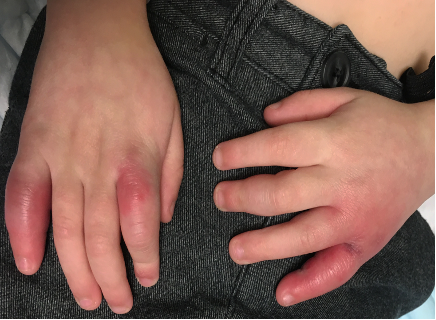Four-year-old with itchy, red, painful hands following snow exposure
The child was otherwise healthy with no prior severe medical issues, and he did not present with COVID-19 symptoms. Can you diagnose this child based on the case below?
FIGURE. Image provided by author

The Case
A 4-year-old boy developed edematous, itchy, painful hands and fingers with erythema while playing out in the snow. The most severe involvement was localized to his upper extremities, specifically in his right index and pinky finger and left pinky finger. The child was otherwise healthy with no prior severe medical issues, and he did not present with COVID-19 symptoms.

Clinical findings
Perniosis, also referred to as pernio or chilblains, is a result of an inflammatory response to the cold or damp, but not to freezing temperatures.1 The lesions result in erythematous, swollen, and red-purple fingers, toes, nose, and/or ears. Pain, tenderness, and itchiness may accompany these lesions (Figure). In severe cases, pernio can cause sores or blisters.

Discussion
The winter weather calls for snowball fights, ice skating, sledding, and other fun outdoor recreational activities. Pediatric health care providers may start seeing pernio in their offices.
Pernio is a condition that mostly affects children and women, particularly those with a low body mass index (BMI) and who live in a damp, cool, but nonfreezing climate.2 However, it is important to consider other clinical conditions that have a similar clinical presentation to pernio, as described in the Table.
Our patient presented with swollen extremities with erythema after playing outside in the cold. Other conditions that can follow a similar presentation include, but are not limited to: frostbite, cold panniculitis, Raynaud phenomenon, acrocyanosis, and chilblain lupus erythematosus. Additionally, since April 2020, the COVID-19 pandemic has also added to the differential diagnosis. There have been several cases of cutaneous manifestations secondary to COVID-19 infection.3 These patients have been documented to have pernio-like lesions on the toes and/or fingers which can be swollen, erythematous, and have a reddish-purple coloration. The moniker “COVID toes” has been given to this symptomatology. However, due to the novel nature of this disease, we have much to learn about the cutaneous sequelae of COVID-19.
Our patient presented with swollen, red-purple lesions on his extremities following an extended period in the cold. He was otherwise healthy and did not present with any influenza-like symptoms. Additionally, his COVID-19 screening test was negative. Based on these findings, the likely diagnosis for this patient is pernio.
Diagnostic criteria
To diagnose perniosis, Mayo Clinic has developed diagnostic criteria, which requires the patient to have 1 major and at least 1 minor criterion2:
Major criterion (required)—localized redness and swelling of affected areas for more than 24 hours.
Minor criteria (at least 1 of the following):
- Onset and/or worsening in cooler months
- Histopathology consistent with chilblains
- Improvement with warming and drying
Management
Pernio is typically treated with conservative measures.4 The first line of treatment is to cover the affected areas by wearing protective clothing such as gloves or socks during the cold winter months. Additionally, patients should avoid reexposing the affected areas to cold conditions. Smoking cessation is recommended if the patient smokes. If conservative measures fail, topical corticosteroids may be utilized as a second line of treatment.
Nifedipine, a calcium channel blocker, may be used to treat pernio due to its vasodilatory effects. However, the effects of nifedipine as a treatment for pernio may not be fully understood. Findings from a randomized controlled trial in 2016 failed to show the benefit of nifedipine over a placebo when treating chronic pernio.5 However, published data from another study support the use of nifedipine to treat pernio.6
Patient outcomes
For this patient, a conservative approach was taken to manage his pernio. His parents were advised to keep his extremities warm by having him wear protective clothing while playing outdoors. A topical steroid should be applied twice daily to the affected areas for 5 days. Oral acetaminophen may be taken for symptomatic pain relief, as needed. This patient was expected to have a good response with these conservative measures. The parents were informed that pernio typically resolves with rest and protective measures over 1 to 3 weeks.
Click here to read more from the January/February issue of Contemporary Pediatrics.
References:
1. Simon TD, Soep JB, Hollister JR. Pernio in pediatrics. Pediatrics. 2005;116(3):e472-e475. doi:10.1542/peds.2004-2681
2. Cappel JA, Wetter DA. Clinical characteristics, etiologic associations, laboratory findings, treatment, and proposal of diagnostic criteria of pernio (chilblains) in a series of 104 patients at Mayo Clinic, 2000 to 2011. Mayo Clin Proc. 2014;89(2):207-215. doi:10.1016/j.mayocp.2013.09.020
3. Wang CJ, Worswick S. Cutaneous manifestations of COVID-19. Dermatol Online J. 2021;27(1):13030/qt2m54r7nv.
4. Hedrich CM, Fiebig B, Hauck FH, et al. Chilblain lupus erythematosus––a review of
literature. Clin Rheumatol. 2008;27(8):949-954. doi:10.1007/s10067-008-0942-9
5. Souwer IH, Bor JHJ, Smits P, Lagro-Janssen ALM. Nifedipine vs placebo for treatment ofchronic chilblains: a randomized controlled trial. Ann Fam Med. 2016;14(5):453-459. doi:10.1370/afm.1966
6. Rustin MH, Newton JA, Smith NP, Dowd PM. The treatment of chilblains with nifedipine: the results of a pilot study, a double-blind placebo-controlled randomized study and a long-term open trial. Br J Dermatol. 1989;120(2):267-275. doi:10.1111/j.1365-2133.1989.tb07792.x

Recognize & Refer: Hemangiomas in pediatrics
July 17th 2019Contemporary Pediatrics sits down exclusively with Sheila Fallon Friedlander, MD, a professor dermatology and pediatrics, to discuss the one key condition for which she believes community pediatricians should be especially aware-hemangiomas.
Young woman with tick bites presents with erythematous papules, headaches, and fatigue
April 8th 2024A young woman with no significant past medical history returns from hiking with several white-spotted ticks and experiences erythematous papules, rashes, headaches, and fatigue. What’s the diagnosis?